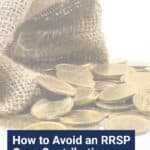How to Avoid an RRSP Over-Contribution

If you’re in a position to maximize your RRSP contributions each year, it’s a good thing. Not only are you benefitting from the tax deductibility, but it means that a larger portion of your investment portfolio is tax-sheltered.
However, you must be careful to stay within your RRSP contribution limit. If you over-contribute, the penalties are steep, and correcting an excess contribution can be an administrative headache. In this article, I’ll explain what constitutes an RRSP over-contribution, what the penalties are, and how to avoid over-contributing.
What Is an RRSP Over-Contribution?
An RRSP over-contribution occurs when your contributions exceed your lifetime deduction limit plus $2000. Canadian tax laws allow a $2000 buffer to account for minor oversights or calculation errors; however, the $2000 exemption is not tax deductible.
RRSP contributions include contributions made to your RRSP account(s) and any contributions made to Specified Pension Plans (SPP) and any Pooled Registered Pension Plans (PRPP).
What Is My RRSP Deduction Limit?
Your RRSP deduction limit is calculated as follows:
- Any unused contribution room from the previous year; plus,
- Current year’s RRSP contribution limit; plus,
- Your pension adjustments reversal (PAR); minus,
- Current year’s RRSP contribution limit; plus,
- Your net past service pension adjustment (PSPA)
The easiest way to check your contribution limit is by checking your previous year’s Notice of Assessment (NOA) or logging into your My Account on the Canada Revenue Agency (CRA) website.
Calculating your previous year’s RRSP deduction limit is fairly straightforward; It’s the lesser of 18% of your earned income in the previous year or the annual RRSP limit ($27,830 for 2021).
For example, if you earned $75,000 in 2021, your annual deduction limit would be $13,500. If your income were $180,000, your limit would be capped at $27,830, the yearly maximum.
Who Can Contribute to an RRSP?
As long as you have an available RRSP deduction limit, you can make RRSP contributions up to your allowable limit until December 31st of the year you turn 71.
If you have a spouse or common-law partner, you can contribute to their RRSP until December 31st of the year they turn 71.
What Is the Penalty for an RRSP Over-Contribution?
If you contribute over the $2000 exemption, you will be charged a penalty (tax) of 1% per month on the over-contribution amount. The penalty is significant. If you over-contribute by $5000, your penalty will be $50 per month or $600 annually.
If you are charged a penalty, you must complete from T1-OVP, Individual Tax Return for RRSP, PRPP, and SPP Excess Contributions and deliver it to your tax centre. You can avoid extra late-filing penalties by paying the tax within 90 days after the end of the calendar year.
The late filing penalty is steep; 5% of the balance owing plus 1% of the balance every month you are late (up to 12 months). The CRA begins to calculate interest on the overcontribution on day 91.
Note: You won’t be subject to the 1% penalty if you withdraw the excess amounts before the end of the month in which the over-contribution was made, or made the contribution to a qualifying group plan.
How to Fix an RRSP Over-Contribution
If you notice an excess contribution before the end of the year, you can minimize its impact by withdrawing the amount from your RRSP, preventing the 1% tax from continuing to accrue.
Keep in mind you will be charged withholding tax on the withdrawal.
To avoid the withholding tax, complete form T3012A, Tax Deduction Waiver on the Refund of your Unused RRSP, PRPP, or SPP Contributions, from your RRSP. You can submit the form to the CRA for certification before making the withdrawal. Once the CRA certifies your form and notifies your RRSP provider, you can make the withdrawal without withholding tax.
If you notice the over-contribution after the end of the year, make sure you withdraw the excess amount and pay the penalty as quickly as possible to avoid any 90+ day late filing penalties.
Can I Request a Penalty Waiver?
According to the CRA, you can request a waiver of the excess contribution tax in writing if you meet the following two conditions:
- Your excess contributions were the result of a reasonable error
- You have taken reasonable steps to correct the excess contributions.
To request a waiver, you will need to fill out form RC2503. On the form, you will need to inform the CRA why you made excess contributions and why you believe it was a reasonable error; and include any correspondence to support your belief. The CRA will make the final decision.
How to Avoid Making an RRSP Over-Contribution
RRSP over-contributions are a hassle and can cost you. But you can avoid them by keeping things simple and adopting a few habits. Here are steps to take to prevent RRSP excess contributions.
1. Only contribute to one RRSP account. Most Canadians deal with more than one financial institution. You can also have multiple RRSP accounts. But if you contribute to more than one RRSP, you increase the chances of an over-contribution. If possible, only contribute to one RRSP plan.
2. Check your Notice of Assessment (NOA). It includes your RRSP deduction limit for that year. Always check your NOA to know how much contribution room you have.
3. Log into your CRA My Account regularly. You can access your tax and benefit information online, including RRSP deduction limits, via a secure portal called CRA My Account. I recommend that you check your account every three months. While your RRSP details won’t change that often, staying on top of your tax affairs is a good idea.
Final Thoughts on RRSP Over-Contribution
You will likely make more costly financial mistakes during your life than over-contributing to your RRSP. That said, it’s important that you know the information to avoid a needless expense, not to mention an enormous hassle.
Remember, it’s up to individual Canadians to keep track of their RRSP deduction limits. Your bank or financial advisor doesn’t have access to your tax affairs and can only see what you hold directly through them. Thankfully, RRSP over-contributions are easily avoided.


Comments
What happens if you have stayed within your contribution limit but retire with contributions in the account that you have not used against employment income?
Wouldn’t you just use those against future
Income eg CCP payments to bring down your tax bill?
Do not rely on information in your account with CRA as they are not up to date.
Can you please comment on TFSA – if I receive dividends in my TFSA when I use them to buy more stock is this considered a contribution?
No
Well written article.
It would have been great to add about using Form T746 to claim deduction for refund of unused RRSP contribution.
And that’s where my question is.
Is it possible to “claim deduction” for “refund of unused RRSP contribution” by filling From T746 for past years ( by way of T1-adjustment request) in following scenario:
-Overcontribution to “self-directed RRSP” was done about 3 years back in 2019 (overcontribution was the result of extra contribution to the “defined benefit plan” by the employer independently and seperately ).
-RRSP funds in excess of overcontribution was withdrawn in the year after overcontribution & reported fully as income on line 12900 in 2020 as well as in 2021..
-So the unused RRSP overcontribution still remains
-Can this overcontribution be deducted on line 23200 by filling form T746 for year 2022 without any penalty,
-or can it be claimed on line 23200 (by filling form T746) retroactively for year 2020 or 2021 by way of T1-Adjustment request..
I hope I am clear about my question
Thanks
Just a reminder that (I think) penalty for overcontribution does not apply if it is because of contribution by employer to “defined benefit Plan” Correct me if I am wrong. Thanks
The article is very concise and informative. I would suggest when talking about the aspect of tax deductability we also make a point about the fact it is actually a tax deferral. Thanks so much